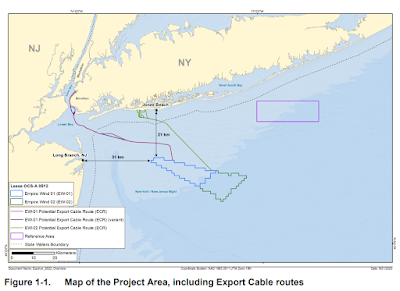Why fisherman should unite to stop the burning of fossil fuels for electricity
Recreational anglers are seeing firsthand that warming waters mean that species are moving farther north than ever before – disrupting fisheries management and throwing off fish migration patterns.
Combined with the fact that offshore wind turbines act as artificial reefs that attract fish, many anglers support responsibly developed offshore wind power. However, conventional electricity generation is also harming fishing in other, less noticeable ways, such as acidification, mortality in power plant cooling intakes, and mercury pollution. All of these are reasons recreational anglers should welcome more clean energy such as offshore wind power in our state.
The burning of fossil fuels for electricity generation creates excess carbon dioxide that, in addition to adding to the greenhouse gas effect, is also deposited in our oceans, making them more acidic. Increased acidity is altering our marine ecosystems and creatures in ways that we cannot readily see, but years of scientific research have given us a very clear understanding of what is going on -- and it’s not good.
Acidity erodes calcium carbonate, which is at the very foundation of many marine creatures. Corals, which provide habitat for one-third of all fish in the ocean, deteriorate with more acidity. The ear bones of many of our game and forage fish are composed of calcium carbonate. Increased acidification alters these bones and can affect the fish’s sense of smell, sense of direction, and hearing.
Shellfish are also composed of calcium carbonate. Scallops, clams, mussels, and oysters are experiencing softer shells because of acidification. The molting cycles of crabs and lobsters are being altered and slowed down. Some forms of plankton also have structures composed of calcium carbonate that are seeing changes in their survival rate, growth, and physiology. In short, acidification could have a drastic effect on the entire marine food web, including game fish we all love to catch.
Additionally, fossil-fuel power generators suck in large volumes of water to provide cooling, trapping and killing numerous fish species in the intakes to do so. Many of these facilities are located in tidal rivers and estuaries -- all key nursery areas for weakfish, summer flounder, bluefish, and striped bass. Important species lower in the food chain like alewife and blueback herring, Atlantic menhaden, American shad, and American eel also reside in these same areas. With so many species present in estuaries, it is estimated that one coastal plant here in New Jersey kills over 70 million fish of 30 species annually in its intake.
Fortunately, many of these power plants are aging out and closing down – some even being repurposed to receive energy from offshore wind farms, reusing grid infrastructure while restoring fish populations.
Many freshwater anglers also know that every single freshwater stream, pond, lake, and river in New Jersey comes with a fish consumption warning. All of our waters are contaminated with heavy metals, especially mercury that build up in freshwater game fish, like bass, catfish, and yellow perch. The same is true for saltwater species like striped bass, bluefish, tuna, and other species in our ocean where mercury accumulates in species of game fish higher in the food chain.
Whether you’re concerned about warming waters, ocean acidification, the impacts of cooling intakes, or mercury contamination, this much is clear: fossil fuel generation is hurting our fishing, and the sooner we can transition to cleaner alternatives, the better.
Thankfully, rapid advances in offshore wind turbine technology over the past decade have drastically improved capacity, offering a cost-effective large-scale alternative to fossil fuels. Turbines along the United States shorelines, including those planned off of New Jersey, can produce nearly two times the current amount of electricity our country uses today.
As 80% of the country’s population lives near our coasts, offshore wind farms are conveniently located near population centers like Boston, New York, and New Jersey. I’m heartened to see that Gov. Phil Murphy recently more than doubled the state’s commitment to offshore wind from 3,500MW by 2030 to 7,500MW by 2035. That’s more good news for recreational anglers.







Truly a great post. Thanks for such a great information.
ReplyDeleteNew York Boat Charters